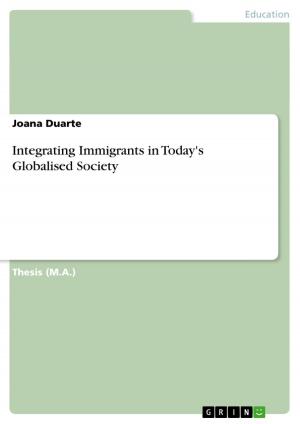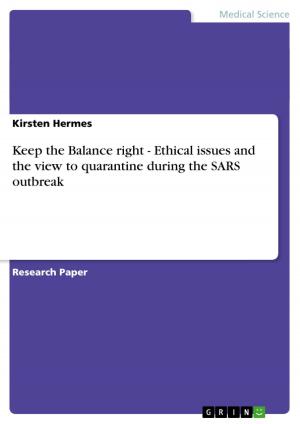International Financial Reporting Standard for Small and Medium-sized Entities
An Evaluation of chosen Proposals
Business & Finance, Accounting| Author: | David Wagener | ISBN: | 9783640142378 |
| Publisher: | GRIN Publishing | Publication: | August 21, 2008 |
| Imprint: | GRIN Publishing | Language: | English |
| Author: | David Wagener |
| ISBN: | 9783640142378 |
| Publisher: | GRIN Publishing |
| Publication: | August 21, 2008 |
| Imprint: | GRIN Publishing |
| Language: | English |
Seminar paper from the year 2008 in the subject Business economics - Accounting and Taxes, grade: 1,3, University of the West of England, Bristol (Bristol Business School (University of the West of England)), course: Externes Rechnungswesen/ Corporate Reporting, 11 entries in the bibliography, language: English, abstract: The Exposure Draft of an IFRS for SMEs published in February 2007 is supposed to enhance the comparability between worldwide SMEs, and therefore meet the user needs, by concentrating on regulations that play a role for SMEs. Furthermore it is expected to reduce the financial reporting burden of the preparers, reporting SMEs without public accountability, of the financial statements. Another benefit, in case of widespread application of the standard, is expected to be the falling costs of capital of SMEs. This is because the allocation and pricing of capital is easier with a higher comparability of the financial statements of SMEs. Major issues of change were the impairment of goodwill, the cost method for associated companies, finance leases as well as the expense of research and development costs. Goodwill is unlike in full IFRSs, tested for impairment losses on indication and impaired only to the fair value. This reduces the workload spent on annual impairment testing but may lead to dilutions of expenses. Associated companies can, also in the consolidated statements, be accounted for with the cost method and the fair value model through profit or loss, which are much easier than the equity method. However, since intra-company transactions are not cancelled out, the new regulations might lead to higher profits. The accounting of finance leases changed in two respects: The regulations of lessor accounting was totally left out of the standard and has to be looked up in full IFRSs. The lessee accounting was simplified by allowing the preparers of the financial statement to determine the cost of the lease by only calculating the fair value of the leased property. This also leads to smaller expenses over the total lease period. When it comes to the research and development expenditure only minor changes were introduced. The IASB decided for providing SMEs with a choice in accountingtreatment between expending both research and development cost or, on the other hand, to capitalize the development cost if certain criteria are met. Although it means a further simplification it has to be doubted that many entities decide against the possibility to capitalize the development cost but to expense them.
Seminar paper from the year 2008 in the subject Business economics - Accounting and Taxes, grade: 1,3, University of the West of England, Bristol (Bristol Business School (University of the West of England)), course: Externes Rechnungswesen/ Corporate Reporting, 11 entries in the bibliography, language: English, abstract: The Exposure Draft of an IFRS for SMEs published in February 2007 is supposed to enhance the comparability between worldwide SMEs, and therefore meet the user needs, by concentrating on regulations that play a role for SMEs. Furthermore it is expected to reduce the financial reporting burden of the preparers, reporting SMEs without public accountability, of the financial statements. Another benefit, in case of widespread application of the standard, is expected to be the falling costs of capital of SMEs. This is because the allocation and pricing of capital is easier with a higher comparability of the financial statements of SMEs. Major issues of change were the impairment of goodwill, the cost method for associated companies, finance leases as well as the expense of research and development costs. Goodwill is unlike in full IFRSs, tested for impairment losses on indication and impaired only to the fair value. This reduces the workload spent on annual impairment testing but may lead to dilutions of expenses. Associated companies can, also in the consolidated statements, be accounted for with the cost method and the fair value model through profit or loss, which are much easier than the equity method. However, since intra-company transactions are not cancelled out, the new regulations might lead to higher profits. The accounting of finance leases changed in two respects: The regulations of lessor accounting was totally left out of the standard and has to be looked up in full IFRSs. The lessee accounting was simplified by allowing the preparers of the financial statement to determine the cost of the lease by only calculating the fair value of the leased property. This also leads to smaller expenses over the total lease period. When it comes to the research and development expenditure only minor changes were introduced. The IASB decided for providing SMEs with a choice in accountingtreatment between expending both research and development cost or, on the other hand, to capitalize the development cost if certain criteria are met. Although it means a further simplification it has to be doubted that many entities decide against the possibility to capitalize the development cost but to expense them.















